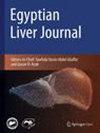Role of magnetic resonance imaging (MRI) in liver iron quantification in thalassemic (thalassemia major) patients
IF 0.7
Q4 GASTROENTEROLOGY & HEPATOLOGY
引用次数: 0
Abstract
Iron overload is a major problem in beta thalassemia patients due to repeated blood transfusions. The liver is the first organ to be loaded with iron. An accurate assessment of iron overload is necessary for managing iron chelation therapy in such patients. Iron quantification by MRI scores over liver biopsy due to its non-invasive nature. Fifty-one patients with thalassemia major were subjected to 3.0-T MRI. Multiecho T2* sequence was used to cover the entire liver. Region of interest (ROI) was placed in three areas with maximum signal change, and an average T2* value was obtained. Similarly, a single ROI was placed at the mid-interventricular septum in the heart, and T2* value was obtained. T2* values so obtained were converted to iron concentration with the help of a T2* iron concentration calculator. The liver iron values were correlated with serum ferritin value. There was a significant negative correlation between liver iron concentration (LIC) and T2* value of the liver (r = − 0.895, p < 0.01) and between cardiac iron concentration (CIC) and T2* value of the heart (r = − 0.959, p < 0.01). There was a slight positive correlation between LIC and serum ferritin (r = 0.642, p < 0.01) and no correlation between CIC and serum ferritin (r = − 0.137, p = 0.354). MRI is a useful tool to titrate the doses of chelating agents as it is accurate and non-invasive, does not involve radiation hazards and hence can be repeated as and when needed. Simultaneous assessment of cardiac iron overload is an added advantage of MRI.磁共振成像(MRI)在地中海贫血(重型地中海贫血)患者肝脏铁定量中的作用
由于反复输血,铁超载是地中海贫血患者的一个主要问题。肝脏是第一个铁负荷过重的器官。准确评估铁超载对此类患者进行螯合铁治疗非常必要。核磁共振成像的铁定量分析因其非侵入性而优于肝活检。51 名重型地中海贫血患者接受了 3.0-T 磁共振成像检查。使用多回波 T2* 序列覆盖整个肝脏。在信号变化最大的三个区域设置感兴趣区(ROI),并获得平均 T2* 值。同样,在心脏室间隔中部放置一个感兴趣区,并获得 T2* 值。利用 T2* 铁浓度计算器将获得的 T2* 值转换为铁浓度。肝脏铁值与血清铁蛋白值相关。肝脏铁浓度(LIC)与肝脏 T2* 值之间呈明显负相关(r = - 0.895,p < 0.01),心脏铁浓度(CIC)与心脏 T2* 值之间呈明显负相关(r = - 0.959,p < 0.01)。LIC 与血清铁蛋白之间存在轻微的正相关性(r = 0.642,p < 0.01),而 CIC 与血清铁蛋白之间没有相关性(r = - 0.137,p = 0.354)。磁共振成像是滴定螯合剂剂量的有用工具,因为它准确、无创、无辐射危害,因此可在需要时重复使用。同时评估心脏铁负荷过重也是核磁共振成像的一大优势。
本文章由计算机程序翻译,如有差异,请以英文原文为准。
求助全文
约1分钟内获得全文
求助全文

 求助内容:
求助内容: 应助结果提醒方式:
应助结果提醒方式:


